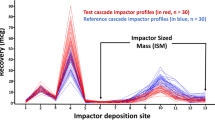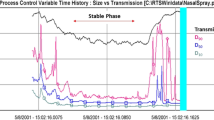Abstract
The aim of this work is to evaluate average bioequivalence (ABE) and population bioequivalence (PBE) statistical approaches so as to identify which approach is most suitable for in vitro bioequivalence (IVBE) testing of nasal spray products. For droplet size distribution (DSD) and spray pattern (SP), in vitro data were collected using a well-established nasal spray on the market (Nasonex®, manufactured by Merck Sharp & Dohme Limited). Simulations were performed using in vitro data to comparatively investigate ABE and PBE tests. For highly variable parameters such as SP area, this study clearly demonstrates that the level of agreement between ABE and PBE test conclusions is much smaller as compared with that of DSD Dv(50), which was found to have moderate variability. PBE approach dictates equivalence for both means and variances, and was found to handle both SP and DSD parameters with similar passing rates compared to the passing rates from the ABE approach. However, pronounced asymmetric behavior of PBE empirical power curves for highly variable SP area was observed. A modified PBE statistical approach is proposed for DSD span and Dv(50) in vitro parameters, where acceptance criteria would be based on comparison of reference/branded product to itself as part of “pre-IVBE study” via innovative statistical bootstrap simulations. Due to inherent high variability of the SP area parameter driving pronounced asymmetric behavior of PBE power curves, and due to unclear in vivo relevance for SP area and ovality, authors propose that SP parameters be used as development and quality control tools rather than for demonstration of IVBE.









Similar content being viewed by others
References
US Food and Drug Administration. Guidance for industry. Bioavailability and bioequivalence studies for nasal aerosols and nasal sprays for local action. 2003. http://www.fda.gov/downloads/drugs/guidancecomplianceregulatoryinformation/guidances/ucm070111.pdf. Accessed 13 Aug 2018.
European Medicines Agency. Guideline on the pharmaceutical quality of inhalation and nasal products (emea/chmp/qwp/49313/2005corr). 2006. http://www.ema.europa.eu/docs/en_GB/document_library/Scientific_guideline/2009/09/WC500003568.pdf. Accessed 13 Aug 2018.
Therapeutic Goods Administration. Guidance 19: inhalation and nasal medicines. 2013. https://www.tga.gov.au/file/5212/download. Accessed 13 Aug 2018.
Health Canada. Guidance for industry pharmaceutical quality of inhalation and nasal products. 2006. http://www.hc-sc.gc.ca/dhp-mps/alt_formats/hpfb-dgpsa/pdf/prodpharma/inhalationnas-eng.pdf. Accessed 13 Aug 2018.
ANVISA Brazil National Health Surveillance Agency. Nota técnica n° 01 de 2013 - cefar-gtfar-ggmed-anvisa (versão 1.1). 2013. http://portal.anvisa.gov.br/documents/33836/349757/Nota+t%C3%A9cnica+n%C2%BA+01+de+2013+-+CEFAR-GTFAR-GGMED-Anvisa/a89c47fd-2558-4659-88ff-95b35a004895. Accessed 13 Aug 2018.
Lee SL, Saluja B, Garcia-Arieta A, Santos GML, Li Y, Lu S, et al. Regulatory considerations for approval of generic inhalation drug products in the US, EU, Brazil, China, and India. AAPS J. 2015;17(5):1285–304. https://doi.org/10.1208/s12248-015-9787-8.
US Food and Drug Administration. Draft guidance on mometasone furoate. 2015. http://www.fda.gov/downloads/drugs/guidancecomplianceregulatoryinformation/guidances/ucm461141.pdf. Accessed 13 Aug 2018.
US Food and Drug and Administration. Draft guidance on budesonide. 2012. http://www.fda.gov/downloads/drugs/guidancecomplianceregulatoryinformation/guidances/ucm319977.pdf. Accessed 13 Aug 2018.
US Food and Drug Administration. Draft guidance document. Statistical information from the june 1999 draft guidance and statistical information for in vitro bioequivalence data posted on august 18, 1999. 2003. http://www.fda.gov/downloads/drugs/guidancecomplianceregulatoryinformation/guidances/ucm070118.pdf. Accessed 13 Aug 2018.
Garcia-Arieta A. A European perspective on orally inhaled products: in vitro requirements for a biowaiver. J Aerosol Med Pulm Drug Deliv. 2014;27(6):419–29.
Steinijans VW. Some conceptual issues in the evaluation of average, population, and individual bioequivalence. Drug Inf J. 2001;35(3):893–9.
Vuorinen J, Turunen J. A three-step procedure for assessing bioequivalence in the general mixed model framework. Stat Med. 1996;15(24):2635–55.
Chow SC. Individual bioequivalence—a review of the FDA draft guidance. Drug Inf J. 1999;33(2):435–44.
Nakai K, Fujita M, Tomita M. Comparison of average and population bioequivalence approach. Int J Clin Pharmacol Ther. 2002;40(9):431–8.
Morgan B, Strickland H. Performance properties of the population bioequivalence approach for in vitro delivered dose for orally inhaled respiratory products. AAPS J. 2014;16(1):89–100. https://doi.org/10.1208/s12248-013-9543-x.
Morgan B, Chen S, Christopher D, Langstrom G, Wiggenhorn C, Getz EB, et al. Performance of the population bioequivalence (PBE) statistical test using an IPAC-RS database of delivered dose from metered dose inhalers. AAPS PharmSciTech. 2018;19(3):1410–25. https://doi.org/10.1208/s12249-017-0941-8.
Sandell D. A real case comparison of average and population bioequivalence for evaluation of APSD data. 2014. http://ipacrs.org/assets/uploads/outputs/08-Day_2_OIC_2014_Sandell.pdf. Accessed 13 Aug 2018.
Efron B. 1977 Rietz lecture—bootstrap methods—another look at the jackknife. Ann Stat. 1979;7(1):1–26. https://doi.org/10.1214/aos/1176344552.
Efron B, Tibshurani RJ. An introduction to the bootstrap. 1st edition ed. London: Chapman & Hall/CRC; 1994.
Mangas-Sanjuan V, Colon-Useche S, Gonzalez-Alvarez I, Bermejo M, Garcia-Arieta A. Assessment of the regulatory methods for the comparison of highly variable dissolution profiles. AAPS J. 2016;18(6):1550–61. https://doi.org/10.1208/s12248-016-9971-5.
Paixao P, Gouveia LF, Silva N, Morais JAG. Evaluation of dissolution profile similarity—comparison between the f(2), the multivariate statistical distance and the f(2) bootstrapping methods. Eur J Pharm Biopharm. 2017;112:67–74. https://doi.org/10.1016/j.ejpb.2016.10.026.
Fuglsang A. Sample size estimation for the U.S. Food and Drug Administration’s in vitro population bioequivalence test of DPIS, MDIS, nasal sprays, and nebules. J Aerosol Med Pulm Drug Deliv. 2017;30:1–2. https://doi.org/10.1089/jamp.2017.1420.
Nasonex Patient Information Insert. http://www.Medicines.Org.Uk/emc/medicine/19853, http://www.medicines.org.uk/emc/medicine/19853. Accessed 13 Aug 2018.
European Medicines Agency. Guideline on the requirements for clinical documentation for orally inhaled products (OIP) including the requirements for demonstration of therapeutic equivalence between two inhaled products for use in the treatment of asthma and chronic obstructive pulmonary disease (COPD) in adults and for use in the treatment of asthma in children and adolescents (cpmp/ewp/4151/00 rev. 1). 2009. http://www.ema.europa.eu/docs/en_GB/document_library/Scientific_guideline/2009/09/WC500003504.pdf. Accessed 12 Aug 2018.
Grmas J, Stare K, Bozic D, Injac R, Dreu R. Elucidation of formulation and delivery device-related effects on in vitro performance of nasal spray with implication to rational product specification identification. J Aerosol Med Pulm Drug Deliv. 2017;30(4):230–46. https://doi.org/10.1089/jamp.2016.1328.
Dayal P, Pillay V, Babu RJ, Singh M. Box-Behnken experimental design in the development of a nasal drug delivery system of model drug hydroxyurea: characterization of viscosity, in vitro drug release, droplet size, and dynamic surface tension. AAPS PharmSciTech. 2005;6(4):E573–85. https://doi.org/10.1208/pt060472.
Guo CN, Stine KJ, Kauffman JF, Doub WH. Assessment of the influence factors on in vitro testing of nasal sprays using Box-Behnken experimental design. Eur J Pharm Sci. 2008;35(5):417–26. https://doi.org/10.1016/j.ejps.2008.09.001.
Liu JP, Chow SC. Sample-size determination for the 2 one-sided tests procedure in bioequivalence. J Pharmacokinet Biopharm. 1992;20(1):101–4. https://doi.org/10.1007/bf01143188.
Phillips KF. Power for testing multiple instances of the two one-sided tests procedure. Int J Biostat. 2009;5(1). https://doi.org/10.2202/1557-4679.1169.
Castelloe J, Watts D. Equivalence and noninferiority testing using sas/stat® software. https://support.sas.com/resources/papers/proceedings15/SAS1911-2015.pdf. Accessed 13 Aug 2018.
Acknowledgements
The authors would like to thank analyst Elena Arsova for conduction of experimental tests.
Author information
Authors and Affiliations
Corresponding author
Additional information
Publisher’s Note
Springer Nature remains neutral with regard to jurisdictional claims in published maps and institutional affiliations.
Rights and permissions
About this article
Cite this article
Grmaš, J., Lužar-Stiffler, V., Dreu, R. et al. A Novel Simulation-Based Approach for Comparing the Population Against Average Bioequivalence Statistical Test for the Evaluation of Nasal Spray Products on Spray Pattern and Droplet Size Distribution Parameters. AAPS PharmSciTech 20, 38 (2019). https://doi.org/10.1208/s12249-018-1223-9
Received:
Accepted:
Published:
DOI: https://doi.org/10.1208/s12249-018-1223-9






